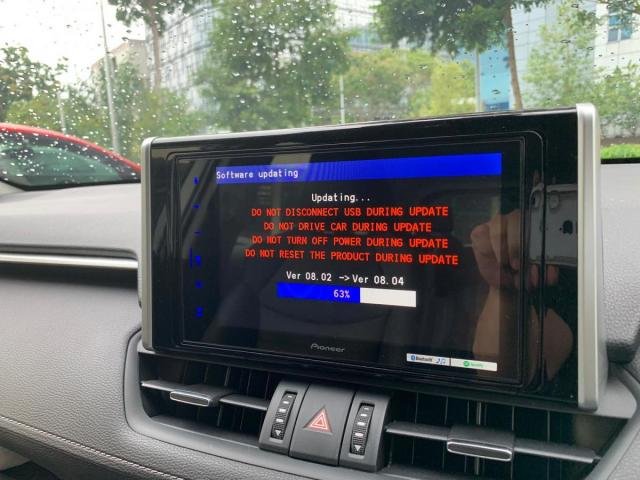Search the Community
Showing results for tags 'firmware'.
-
This headunit is currently compatible with the 2019 RAV4 (can be compatible with other cars too, do update in this thread). I will post the steps to do the firmware update. Download the firmware file from the Pioneer website. https://sg.pioneercarentertainment.com/downloads This is the 18th March 2019 update. Version 08.04 https://sg.pioneercarentertainment.com/downloads_tc?title=DMH-ZS8250BT&link=https%3A%2F%2Fcms.pioneercarentertainment.com%2Ffiles%2FFirmware%2FDMH-ZS8250BT_v08-04.zip Use an empty thumb drive, format it to FAT32 and copy only the firmware file CVJ3242-B.avh into the drive. Follow these steps. Switch on the car's ignition and let the engine run. You should get to here... Wait for it to reach 100% (it will take a couple of minutes to load) and wait for the unit to reboot. Once the headunit is rebooted go to the settings, firmware Information, double check it's the updated version. You may off the ignition and pull out the thumb drive. Well done. You have successfully updated the headunit's firmware.
-
http://www.edn.com/design/automotive/4423428/Toyota-s-killer-firmware--Bad-design-and-its-consequences Toyota's killer firmware: Bad design and its consequences Michael Dunn - October 28, 2013 70 Comments On Thursday October 24, 2013, an Oklahoma court ruled against Toyota in a case of unintended acceleration that lead to the death of one the occupants. Central to the trial was the Engine Control Module's (ECM) firmware. Embedded software used to be low-level code we'd bang together using C or assembler. These days, even a relatively straightforward, albeit critical, task like throttle control is likely to use a sophisticated RTOS and tens of thousands of lines of code. With all this sophistication, standards and practices for design, coding, and testing become paramount – especially when the function involved is safety-critical. Failure is not an option. It is something to be contained and benign. So what happens when an automaker decides to wing it and play by their own rules? To disregard the rigorous standards, best practices, and checks and balances required of such software (and hardware) design? People are killed, reputations ruined, and billions of dollars are paid out. That's what happens. Here's the story of some software that arguably never should have been. For the bulk of this research, EDN consulted Michael Barr, CTO and co-founder of Barr Group, an embedded systems consulting firm, last week. As a primary expert witness for the plaintiffs, the in-depth analysis conducted by Barr and his colleagues illuminates a shameful example of software design and development, and provides a cautionary tale to all involved in safety-critical development, whether that be for automotive, medical, aerospace, or anywhere else where failure is not tolerable. Barr is an experienced developer, consultant, former professor, editor, blogger, and author. Barr's ultimate conclusions were that: Toyota’s electronic throttle control system (ETCS) source code is of unreasonable quality. Toyota’s source code is defective and contains bugs, including bugs that can cause unintended acceleration (UA). Code-quality metrics predict presence of additional bugs. Toyota’s fail safes are defective and inadequate (referring to them as a “house of cards” safety architecture). Misbehaviors of Toyota’s ETCS are a cause of UA. A damning summary to say the least. Let's look at what lead him to these conclusions: Hardware Although the investigation focused almost entirely on software, there is at least one HW factor: Toyota claimed the 2005 Camry's main CPU had error detecting and correcting (EDAC) RAM. It didn't. EDAC, or at least parity RAM, is relatively easy and low-cost insurance for safety-critical systems. Other cases of throttle malfunction have been linked to tin whiskers in the accelerator pedal sensor. This does not seem to have been the case here. The Camry ECM board. U2 is a NEC (now Renesas) V850 microcontroller. Software The ECM software formed the core of the technical investigation. What follows is a list of the key findings. Mirroring (where key data is written to redundant variables) was not always done. This gains extra significance in light of … Stack overflow. Toyota claimed only 41% of the allocated stack space was being used. Barr's investigation showed that 94% was closer to the truth. On top of that, stack-killing, MISRA-C rule-violating recursion was found in the code, and the CPU doesn't incorporate memory protection to guard against stack overflow. Two key items were not mirrored: The RTOS' critical internal data structures; and—the most important bytes of all, the final result of all this firmware—the TargetThrottleAngle global variable. Although Toyota had performed a stack analysis, Barr concluded the automaker had completely botched it. Toyota missed some of the calls made via pointer, missed stack usage by library and assembly functions (about 350 in total), and missed RTOS use during task switching. They also failed to perform run-time stack monitoring. Toyota's ETCS used a version of OSEK, which is an automotive standard RTOS API. For some reason, though, the CPU vendor-supplied version was not certified compliant. Unintentional RTOS task shutdown was heavily investigated as a potential source of the UA. As single bits in memory control each task, corruption due to HW or SW faults will suspend needed tasks or start unwanted ones. Vehicle tests confirmed that one particular dead task would result in loss of throttle control, and that the driver might have to fully remove their foot from the brake during an unintended acceleration event before being able to end the unwanted acceleration. A litany of other faults were found in the code, including buffer overflow, unsafe casting, and race conditions between tasks.
-
seems that there is an update to columbus RNS510 check it for owners having this http://briskoda.net/ice-security-insurance...-2664-a/155343/ http://vwnavi.com/forums/showthread.php?t=11333&page=2 maybe it does fix the NAVI issue?
-
Omnia has rolled out new firmware, i900DXHJ1, this firmware will resolve the battery killer problem. http://www.samsungmobile.com/promotion/omnia/index.jsp My friend upgrade hers from HH1 to HJ1, tested it for three weeks, and the software is stable. My version is G2 and not sure if I should upgrade mine to HJ1 too. Anybody else upgraded to HJ1 too, and what other improvements for HJ1??
-
Wonder when will that day come when we can upgrade our car's firmware to improve performance FOC, just like our handphones ? Machiam like tweaking Windows registry, any change in parameters will have different results.
- 6 replies
-
- User
- upgradeable
-
(and 2 more)
Tagged with:






